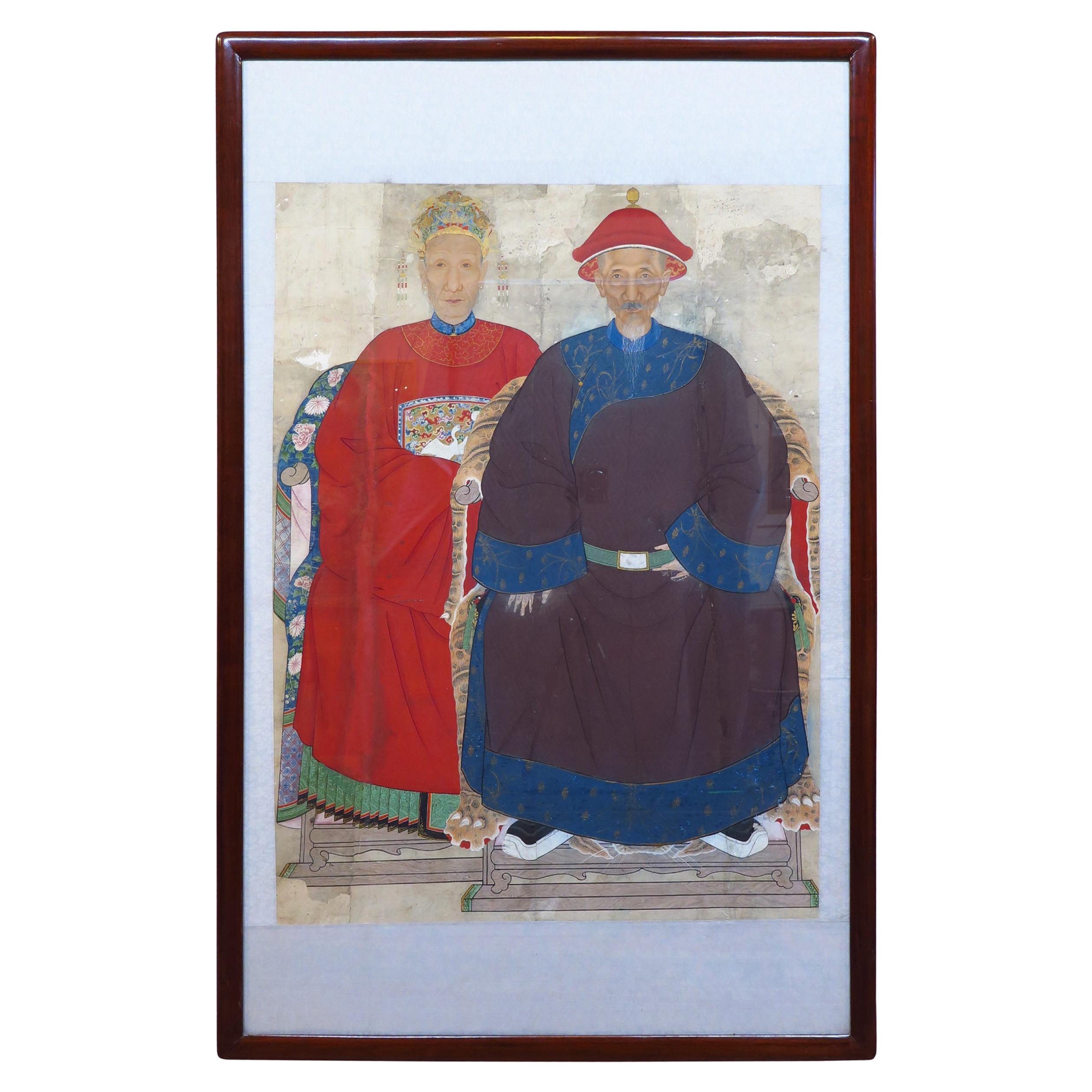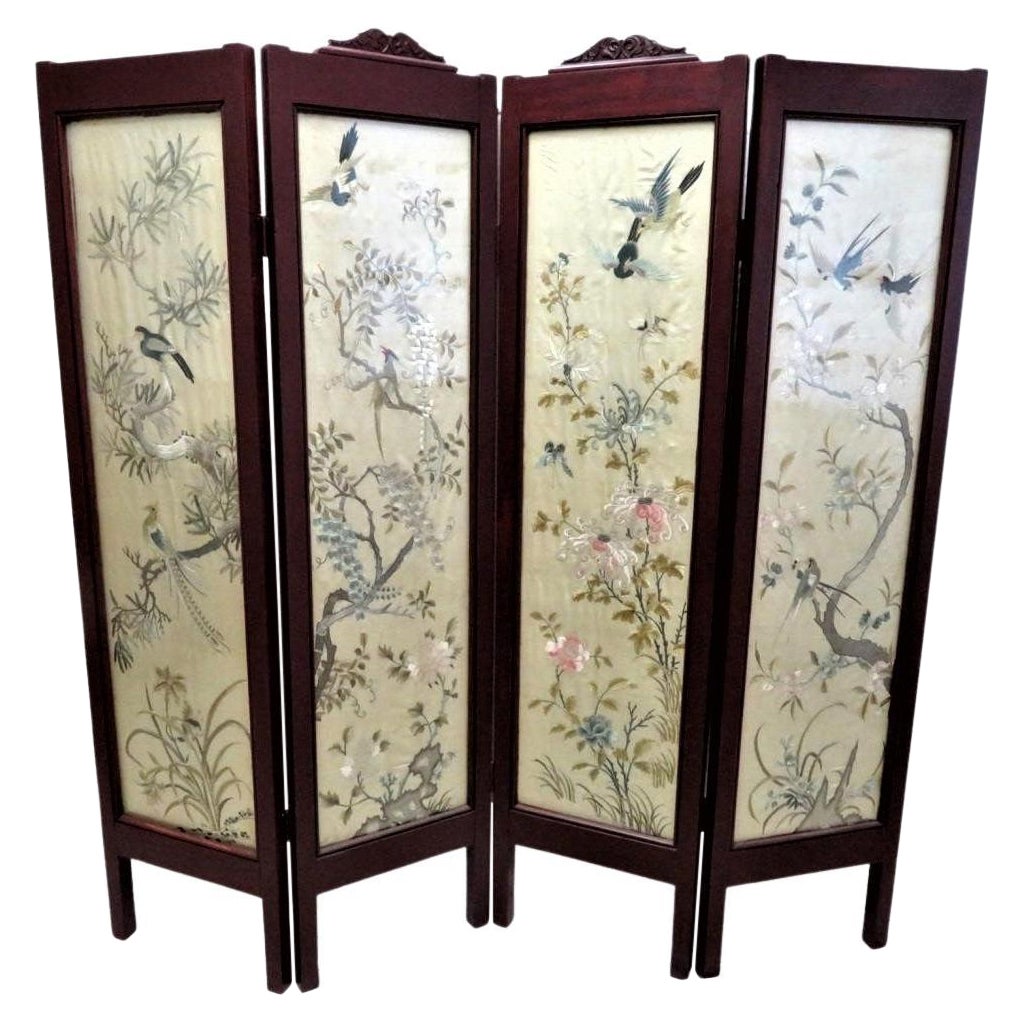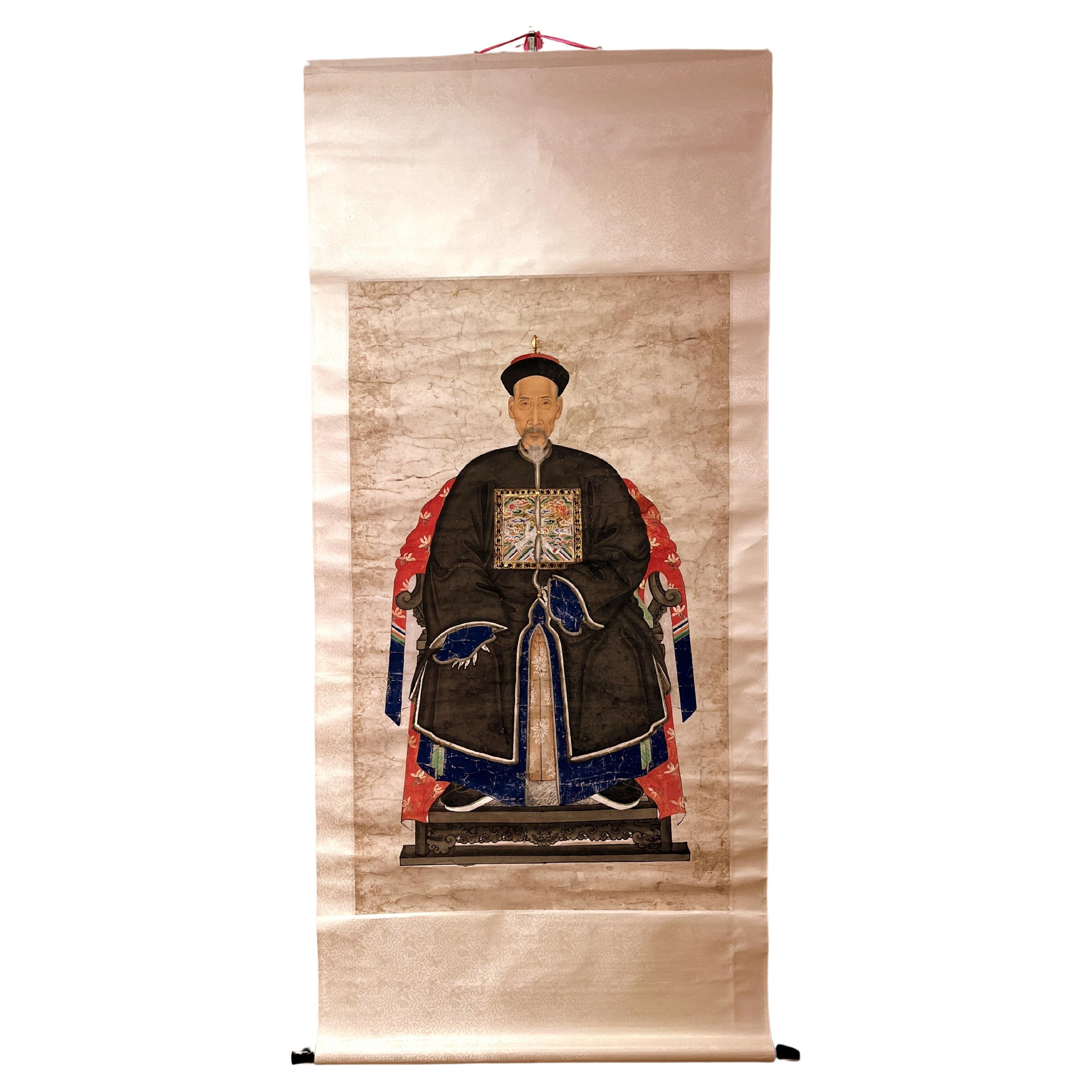Items Similar to Framed Pair of Antique Chinese Qing Dynasty Ancestor Paintings on Silk
Want more images or videos?
Request additional images or videos from the seller
1 of 15
Framed Pair of Antique Chinese Qing Dynasty Ancestor Paintings on Silk
About the Item
Antique pair of Qing dynasty ancestor portraits depicting a male and a female. Hand painted on silk and framed under glass within a large textured silk border. The glass made it difficult to photograph these paintings and the photos do not do full justice to them.
Family members commissioned ancestor portraits to commemorate deceased relatives. These paintings were treated with the greatest respect. On certain holidays, families would honor their ancestors by bowing before the portraits and placing food in front of them. If properly cared for, ancestors contributed to wealth and good fortune for their descendants. If ignored, ancestors could turn into nasty ghosts who would bring bad luck.
Ancestor portraits have a long history in China and stems from filial piety. This one dates from the early part of the Qing dynasty (1644–1911), the last imperial dynasty. Ancestor portraits were usually painted in pairs, as in the case here. Family members commissioned most ancestor portraits. They were painted in workshops as the result of collaboration among several artists, few of whom ever signed their names. Workshop organization was highly specialized, and tasks were divided according to skill. The newest, least-skilled artisans might paint only the ancestor’s hat or shoes, while master artists painted faces. Faces were the most important part of the portrait, because they needed to be realistic and individualized; in contrast, the body and its clothing were used to describe social status and did not need to be personalized.
To simplify production, some artists used stencils to draw the bodies and the chairs. Other artists used grids to create the proper proportions for bodies. They could draw a grid in charcoal, which would be erased when painting.
Painting faces required the most skill—in painting just the eyes and eyebrow hairs, artists might use brushes of six different sizes. Painting accurate faces was important, which created a problem if the subject of the portrait was already dead. The artist might bring a sketchbook of faces for clients to look over. The family would then select features based on the sketches—for example, “ears like those on sketch 2 and a nose like that on sketch 5.” Other times, artists would study the features of living relatives and draw the ancestor portrait based on common features. If necessary, the artist would view the corpse—but only if the deceased was male, since ideas about virtue declared that women should not be seen by outsiders.
Ancestors were usually shown in their best dress, which gives us a way to judge the rank of a subject even if we don’t know his or her identity. The most formal costume in the Qing wardrobe was called chaofu, “court dress.” Chao fu did not refer to a single garment but to an entire outfit, the way a “tuxedo” consists of a shirt, pants, jacket, tie, and cummerbund. Chao fu required a court hat, robe, necklace, and belt, all with prescribed decorations and symbols.
Dimensions (each):
25" W x 48.5" H x 0.75" D (frame)
21.25" W x 445" H (under glass including border)
17.75" W x 34.25" H (painted portrait)
Condition:
Good. No visible signs of wear or fading. Not examined out of frame. Some scuffs to frame. Show well. Ready to hang.
- Dimensions:Height: 48.5 in (123.19 cm)Width: 25 in (63.5 cm)Depth: 0.75 in (1.91 cm)
- Style:Qing (Of the Period)
- Materials and Techniques:
- Place of Origin:
- Period:
- Date of Manufacture:Unknown
- Condition:Wear consistent with age and use.
- Seller Location:Morristown, NJ
- Reference Number:1stDibs: LU5990232790472
About the Seller
4.9
Platinum Seller
These expertly vetted sellers are 1stDibs' most experienced sellers and are rated highest by our customers.
Established in 2020
1stDibs seller since 2021
122 sales on 1stDibs
Typical response time: <1 hour
- ShippingRetrieving quote...Ships From: Morristown, NJ
- Return PolicyA return for this item may be initiated within 14 days of delivery.
More From This SellerView All
- Large Vintage Framed Pichhavai Painting of Krishna Playing His FluteLocated in Morristown, NJVintage Pichhavai painting on fabric of Krishna playing is flute with Radha and female Gopis gathered by his side. The colors, details and facial ex...Category
Vintage 1970s Indian Folk Art Paintings and Screens
MaterialsFabric, Wood, Paint
- Large Vintage Framed Pichhavai Painting of Krishna, Radha and Gopis by MoonlightLocated in Morristown, NJVintage Pichhavai painting on fabric of Krishna, Radha and female Gopis. Krishna walking with Radha and the Gopis by moonlight. The colors, details...Category
Vintage 1970s Indian Folk Art Paintings and Screens
MaterialsFabric, Wood, Paint
- Antique Double Sided Japanese Ranma Transom Panels - a PairLocated in Morristown, NJ19th/20th c., Antique hand-carved Japanese ramna panels depicting landscapes of black pine trees, temples, mountains and clouds. Likely carved from yaku cedar in the Osaka tradition of chokokuranma (carved transom), these are double sided three-dimensional landscape designs. The design is mirrored on each side of the panel. Ranma panels...Category
Antique Late 19th Century Japanese Meiji Paintings and Screens
MaterialsWood, Cedar
- Early 20th Century Japanese 6-Panel Gouache and Gold Leaf Painted Table ScreenLocated in Morristown, NJ20th c., Showa period gouache and gold leaf Japanese screen. Depicting plum tree blossoms on a riverbank across 6 panels. Plum blossoms are often mentioned in Japanese poetry as a symbol of spring...Category
20th Century Japanese Showa Paintings and Screens
MaterialsGold Leaf
- 19th C. A Framed Pair of Regency English Portraits - Oil on CanvasLocated in Morristown, NJ19th c. Regency English/European School. Formal portraits of a husband and wife in formal dress. The background depicts a distant mountain landscape. Oil on canvas with original stre...Category
Antique 1810s English Regency Paintings
MaterialsCanvas, Giltwood, Paint
- Small Contemporary Naive Painting of Chestnut Horse Matted and FramedLocated in Morristown, NJA small and engaging contemporary painting of a chestnut horse in a pastoral setting. The colors in this unsigned painting are fresh and vibrant. The...Category
2010s American Modern Contemporary Art
MaterialsGlass, Wood, Paint, Paper
You May Also Like
- Chinese Ancestor Painting Qing DynastyLocated in New York, NYQing Dynasty Chinese Ancestor painting. Antique Chinese Ancestor paintings are sought after for their warm colors and traditional pa...Category
Antique 1890s Chinese Qing Paintings
MaterialsPaper
- Chinese Silk Embroidered Screen or Room Divider Believed to Be Late Qing DynastyLocated in Nova Scotia, NSWhat a magnificent one-of-a-kind Valentine's Day gift this would be! Wow!! Four panel Chinese silk embroidered screen or room divider believed to be created during the late Qing Dynasty. Four ivory silk embroidered panels housed in a wooden frame form the screen or room divider. The 100 bird...Category
Early 20th Century Chinese Qing Paintings and Screens
MaterialsSilk, Wood, Leather, Fabric, Textile, Tapestry, Thread, Natural Fiber, G...
- Chinese Qing Dynasty Ancestor Imperial Officer Hanging Scroll PaintingLocated in Greenwich, CTQing Dynasty Chinese Ancestral Imperial Officer's Portrait, 19th Century, The imperial officer seated in dignify posture on horseshoe back chair wearing a official hat and with rank ...Category
Antique 19th Century Chinese Qing Paintings and Screens
MaterialsQuartz
- Framed Chinese Embroidered Silk Collar Qing DynastyLocated in Atlanta, GAA silk collar from China dated to late Qing Dynasty circa 19th century. Known as Yunjian (Cloud Shoulder or Cloud Collar), this multi-lobed textile piece was a detachable collar worn around the shoulders as part of the traditional Chinese garment accessory. With its origin dated back to the Han Dynasty and being used until the end of Qing Dynasty, the form evolves with time, but much of the ornamentation and fundamental symbolism remains the same. This striking example features a two-tiered design with seven lobes on each circle, all of which are variations of the shape of auspicious "ruyi", which represents the head of Lingzhi mushroom, a symbol of longevity. The inner lobes feature elaborate embroidery floral design with long and short satin stitches. Notably, one panel has a double gourd design, the symbol of fortune. The outer lobes show a simpler but bolder vision with the outlines of the designs lineated with metallic threads buddled in chain stitches. Small jade beads were used to link the piece together and most of them still remain. The piece as a whole has a very pleasant lilac purple color, delicate with the jade beads. In Qing Dynasty, the silk collar with high quality was worn by noble or aristocratic women. The red color and the lotus boy symbol indicate that it was most likely part of the fashion accouterment worn during wedding ceremony. The collar is beautifully float mounted within a double conforming mat in a giltwood frame and wood backing. A stunningly presented period piece with story to tell. Reference: For a collection of Chinese embroidered collars...Category
Antique Early 19th Century Chinese Qing Textiles
MaterialsSilk
- Framed Chinese Embroidered Silk Collar Qing DynastyLocated in Atlanta, GAAn embroidered silk collar from China dated to late Qing Dynasty circa 19th century. Known as Yunjian (Cloud Shoulder or Cloud Collar), this multi-lobed t...Category
Antique Early 19th Century Chinese Qing Textiles
MaterialsSilk
- Framed Chinese Embroidered Silk Collar Qing DynastyLocated in Atlanta, GAAn embroidered silk collar from China dated to late Qing Dynasty circa 19th century. Known as Yunjian (Cloud Shoulder or Cloud Collar). This striking example features a two-tiered design with eleven inner and outer lobes radiating in a circular fashion. The red inner lobes feature floral embroidery design in satin stitches, the border with twisted chain stitches. The outer lobes are in the shape of auspicious "ruyi", which represents the head of Lingzhi mushroom, a symbol of longevity. Each showcases fine needlework of butterfly with spread wings and various floral motif. A small ball clasp remains on the front. This textile art is beautifully presented in a giltwood frame floating within a double mat of conforming shape. Detachable collars such as this were worn around the shoulders as part of the traditional Chinese garment...Category
Antique 19th Century Chinese Qing Textiles
MaterialsSilk
Recently Viewed
View AllMore Ways To Browse
Framed Pairing
Silk Pair
Framed Silk
Antiques On 5
Painted On Silk
Pair Of Antique Frames
Antique Pair Frames
Antique Paintings On Glass
Antique Painting On Glass
Painting On Glass Antique
Antique Wood Painting Frames
Antique Wood Framed Paintings
Silk Paint Framed
Pair Of Antique Chinese
Large Antique Frames Wood
Pair Of Paintings Large
Antique Asian Silk
Antique China Paintings





